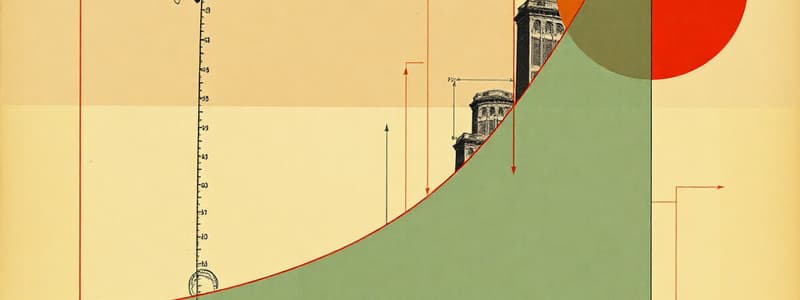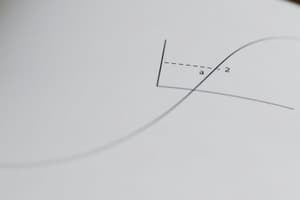Podcast
Questions and Answers
Why did early mathematicians consider finding the area under curves to be an important problem?
Why did early mathematicians consider finding the area under curves to be an important problem?
- It simplified complex geometric proofs.
- It allowed for the calculation of volumes of regular solids.
- It helped in the development of abstract algebra.
- It directly related to problems involving rates of change. (correct)
In the context of approximating the area under a curve, what does Σ(Ai) from i=1 to n represent?
In the context of approximating the area under a curve, what does Σ(Ai) from i=1 to n represent?
- The product of the areas of n rectangles.
- The average area of n rectangles.
- The area of the largest rectangle under the curve.
- The sum of the areas of n rectangles. (correct)
Why is it important to use equal-sized subintervals when approximating the area under a curve?
Why is it important to use equal-sized subintervals when approximating the area under a curve?
- It allows for the use of more advanced calculus techniques.
- It minimizes the amount of computation required.
- It simplifies the mathematics and ensures more consistent calculations. (correct)
- It guarantees that the approximation will be exactly equal to the true area.
How does increasing the number of rectangles (N) generally affect the approximation of the area under a curve?
How does increasing the number of rectangles (N) generally affect the approximation of the area under a curve?
If an object moves with a velocity described by $v(t) = 2t + 1$ (where $v$ is in m/s and $t$ is in seconds) from $t = 0$ to $t = 2$, what does the area under the curve of $v(t)$ represent?
If an object moves with a velocity described by $v(t) = 2t + 1$ (where $v$ is in m/s and $t$ is in seconds) from $t = 0$ to $t = 2$, what does the area under the curve of $v(t)$ represent?
Given an interval [A, B] on the x-axis, what does Δx = (B - A) / N represent in the context of approximating area under a curve?
Given an interval [A, B] on the x-axis, what does Δx = (B - A) / N represent in the context of approximating area under a curve?
An engineer wants to approximate the area under a curve representing the stress on a bridge over time. Why might this be important?
An engineer wants to approximate the area under a curve representing the stress on a bridge over time. Why might this be important?
When using rectangles to approximate the area under a curve, what determines the height of each rectangle?
When using rectangles to approximate the area under a curve, what determines the height of each rectangle?
If you are given a curve $f(x) = x^2$ and you want to approximate the area under this curve from $x = 1$ to $x = 3$ using 4 rectangles of equal width, what is the width (Δx) of each rectangle?
If you are given a curve $f(x) = x^2$ and you want to approximate the area under this curve from $x = 1$ to $x = 3$ using 4 rectangles of equal width, what is the width (Δx) of each rectangle?
Why might the approximation of area under a curve using rectangles be inaccurate?
Why might the approximation of area under a curve using rectangles be inaccurate?
In economics, a curve represents the rate of consumer spending over time. What could the area under this curve signify?
In economics, a curve represents the rate of consumer spending over time. What could the area under this curve signify?
Suppose you are approximating the area under a decreasing curve. If you use the right endpoint of each subinterval to determine the height of the rectangles, will this likely result in an overestimation or an underestimation of the true area?
Suppose you are approximating the area under a decreasing curve. If you use the right endpoint of each subinterval to determine the height of the rectangles, will this likely result in an overestimation or an underestimation of the true area?
A biologist is tracking the growth rate of a bacteria culture. The growth rate is modeled by a curve on a graph. What could the area under the growth rate curve represent?
A biologist is tracking the growth rate of a bacteria culture. The growth rate is modeled by a curve on a graph. What could the area under the growth rate curve represent?
Why is Δx calculated as (B - A) / N, and not some other calculation?
Why is Δx calculated as (B - A) / N, and not some other calculation?
How does the concept of area under a curve relate to understanding total rainfall during a storm, given a graph of rainfall rate (inches per hour) versus time?
How does the concept of area under a curve relate to understanding total rainfall during a storm, given a graph of rainfall rate (inches per hour) versus time?
What is a 'subinterval' in the context of approximating the area under a curve?
What is a 'subinterval' in the context of approximating the area under a curve?
A physicist graphs the power consumption of a device over time. What information can be obtained by finding the area under this curve?
A physicist graphs the power consumption of a device over time. What information can be obtained by finding the area under this curve?
When approximating the area under a curve, using a computer program, which of the following approaches would likely yield the best approximation (assuming no rounding errors)?
When approximating the area under a curve, using a computer program, which of the following approaches would likely yield the best approximation (assuming no rounding errors)?
Why is consistency important when selecting methods for approximating the area under a curve?
Why is consistency important when selecting methods for approximating the area under a curve?
You use rectangles to approximate the area under a curve and notice that the rectangles consistently overshoot the curve. What adjustment would likely improve the accuracy of your approximation?
You use rectangles to approximate the area under a curve and notice that the rectangles consistently overshoot the curve. What adjustment would likely improve the accuracy of your approximation?
Flashcards
Area Under a Curve
Area Under a Curve
Area between a curve and the x-axis between two points.
Area Approximation
Area Approximation
Approximate the area using rectangles under the curve.
Subintervals
Subintervals
Segments along the x-axis within interval [A, B].
Equal-Sized Subintervals
Equal-Sized Subintervals
Signup and view all the flashcards
Δx Calculation
Δx Calculation
Signup and view all the flashcards
Sigma Notation
Sigma Notation
Signup and view all the flashcards
Study Notes
- The goal is to determine the area under a curve between points A and B on the x-axis.
Importance of Finding Area Under a Curve
- Finding the area under a curve has significance in various applications demonstrated by the example of constant velocity.
- For an object moving at a constant velocity of 60 mph for 3 hours, the distance traveled is 180 miles, calculated by multiplying velocity and time.
- The area under the velocity curve, which is a straight line at 60 mph from 0 to 3 hours, is also 180, correlating area under curve with distance.
- Area under a curve refers to the area between the curve and the x-axis, from a given starting point to an ending point.
- Early mathematicians recognized the importance of finding the area under curves as it relates to problems involving rates of change.
Approximating Area Under a Curve Using Rectangles
- A rudimentary approach to approximating the area under a curve involves building rectangles under the curve between the curve and the x-axis.
- The area under the curve is approximated by summing the areas of these rectangles.
- The area of each rectangle is determined by base times its height.
- Notation for summing the areas, A1 + A2 + A3 + A4 + A5 etc, can be written as Σ(Ai) as i goes from one to five, using sigma notation.
Subintervals and Consistent Methods
- The width selection of the rectangles or subintervals can vary, leading to different approximations of the area, therefore mathematicians seek consistent methods.
- Subintervals are segments along the x-axis within the interval [A, B], and are smaller than the overall interval from A to B.
Creating Equal-Sized Subintervals
- To ensure consistency, subintervals of equal size are important for consistent area under the curve calculations.
- Determine N which is the number of subintervals desired.
- Given an interval from A to B, the length of the interval is B minus A, assuming B is greater than A.
- To split the interval into subintervals of equal width, calculate the width Δx as (B - A) / N.
- Δx represents the change in x and ensures each subinterval has the same width, promoting uniformity in your calculations.
Studying That Suits You
Use AI to generate personalized quizzes and flashcards to suit your learning preferences.




